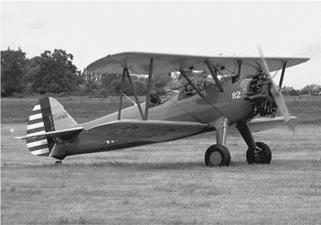Biplane
A biplane is a fixed-wing aircraft with two superimposed main wings. The Wright brothers’ Wright Flyer used a biplane design, as did most aircraft in the early years of aviation. While a biplane wing structure has a structural advantage, it generates more drag than a similar monoplane wing. Improved structural techniques and materials and the quest for greater speed made the biplane configuration obsolete for most purposes by the late 1930s.
In a biplane aircraft, two wings are placed one above the other, as in the Boeing Stearman E75 (PT-13D) biplane of 1944 shown in Figure 1.6. Both wings provide part of the lift, although they are not able to produce twice as much lift as a single wing of similar size and shape because both the upper and lower wings are working on nearly the same portion of the atmosphere. For example, in a wing of aspect ratio 6, and a wing separation distance of one chord length, the biplane configuration can produce about 20% more lift than a single wing of the same planform.
|
Figure 1.6 Boeing Stearman E75 (PT-13D) biplane of 1944. |
In the biplane configuration, the lower wing is usually attached to the fuselage, while the upper wing is raised above the fuselage with an arrangement of cabane struts, although other arrangements have been used. Almost all biplanes also have a third horizontal surface, the tailplane, to control the pitch, or angle of attack of the aircraft (although there have been a few exceptions). Either or both of the main wings can support flaps or ailerons to assist lateral rotation and speed control; usually the ailerons are mounted on the upper wing, and flaps (if used) on the lower wing. Often there is bracing between the upper and lower wings, in the form of wires (tension members) and slender inter-plane struts (compression members) positioned symmetrically on either side of the fuselage.












